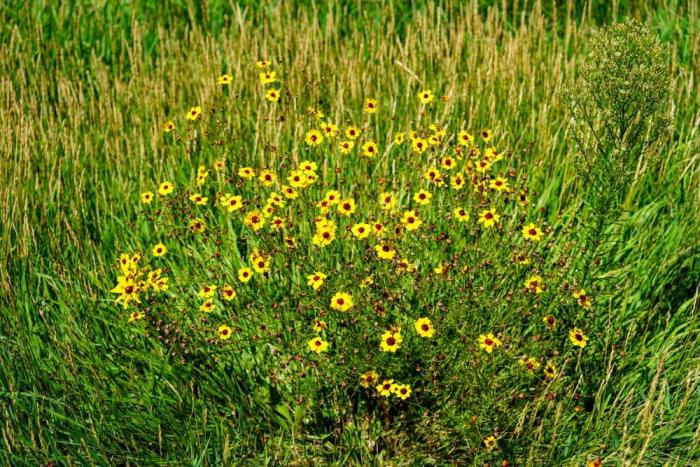New ‘wild’ look greets drivers in Denver’s Central Park neighborhood
Drivers on Quebec Street in northeast Denver have noticed a “wild” change in the landscape on the four medians in the busy corridor just south of Interstate 70.
What was once 10 acres of bland, homogenous Kentucky bluegrass is now in the middle of a landscape transformation project that will conserve more than 8.5 million gallons of water annually.
Denver’s Parks and Recreation department initiated the change in 2023 in partnership with Denver Water, which helped fund the medians’ makeover into prairie grass fields.
“The old grass wasn’t being used for any type of recreational activities, and we were using a lot of water to keep the fields green, so that made the area a good candidate for landscape transformation,” said Ian Schillinger-Brokaw, an associate urban ecology planner at Denver’s Parks and Recreation department.
In 2023, the department got rid of the old grass and reseeded the medians with 60 plant species, including prairie grasses, wildflowers and shrubs.
Learn more about ColoradoScaping at denverwater.org/Conserve.
“The goal of this project is to conserve water, improve biodiversity in the city, and create a space that is representative of the native landscapes for this part of Colorado,” Schillinger-Brokaw said.
The old bluegrass required about 10.5 million gallons of supplemental irrigation every year, but the new grasses and plants will thrive with little to no additional water once they are established around 2026.
The department will continue to water the trees and provide irrigation to the field as needed while the new plants are establishing and during hot and dry times.
“Projects like this are important here in Colorado because water is a scarce resource,” said Austin Krcmarik, a water efficiency planner at Denver Water. “We’re encouraging our community to look at areas with nonfunctional grass and transform them into more climate-appropriate landscapes.”
Get expert tips on re-wilding your yard from speakers at Denver Water’s April 2024 workshop on ColoradoScaping.
Schillinger-Brokaw said Kentucky bluegrass used to be the default type of landscape cover across much of city-owned property for decades, which is why it is so prevalent, but the city’s Parks and Recreation department changed its policy in 2023. Now there is clearer direction on where to use bluegrass and where native grasses and wildflowers should be considered.
“We want to have landscapes that fit our climate,” Schillinger-Brokaw said. “So, we’re looking at properties across the city to see if transformation to more water-wise landscapes is appropriate.”
The city has received calls from residents asking about the new look of the Quebec Street medians with concerns about the brown spots and weeds.
Schillinger-Brokaw says the medians are in a transition period and asks residents for patience as the new plants grow.
“It does look different, but we’re pleased with how much growth we’ve seen in the first season. The new plants will continue to fill in over time,” he said. “The area looks a little wild and unkept right now, but that was by design. We want people to know this site is being intensely managed. We are removing weeds and may reseed some areas in the future.”
See how the Quebec Street medians ColoradoScaping project started in 2023.
He said residents can look at nearby areas like the greenway on 39th Avenue and Westerly Creek Park to see what the Quebec Street medians will look like in the future.
Once the medians’ transformation to a prairie meadow is complete, there will be a variety of plants and grasses of different heights and textures, along with a variety of colors from wildflowers that will bloom at different times of the year.
A key part of the transformation is to add biodiversity, which creates new habitat for pollinators, like birds, bees and insects that are crucial to crops, plants and wildlife.
“It’s important to rethink our landscapes in the city where we only get about 15 inches of moisture each year,” Krcmarik said. “When people drive by, I hope they realize that the prairie look is a different type of beauty that uses a lot less water.”
Schillinger-Brokaw said saving water on landscapes that aren’t used for recreation allows the department to use water more strategically on places where Kentucky bluegrass works, like athletic fields and event spaces in traditional parks.
The Quebec Street medians project is an example of Denver’s Game Plan for a Healthy City, which includes the It’s In Denver’s Nature campaign.
It’s all part of the department’s investment in the city’s fight against climate change through a variety of programs and projects. Efforts include conserving water, transforming landscapes, growing the urban forest, protecting habitats and instilling a spirit of environmental stewardship across the city.
“We’re excited about this project and hope residents will enjoy watching the area change over time,” Schillinger-Brokaw said. “The landscape change on all four medians is really going to be fun for people to see as they drive through the area.”







